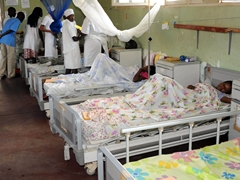Ms. Akiko Miyashita walks briskly along the crowded corridors of the 500-bed Prince Regent Charles Hospital in Bujumbura, Burundi. It is a huge facility which unfortunately, had deteriorated during the country's turbulent past, but is now undergoing rigorous refurbishment.
Ms. Miyashita is familiar with the hospital and the staff know her well. She stops almost after a few steps to answer greetings and exchange niceties with colleagues she has worked with for the past two years. As a staff of JICA Burundi Office, she has been coordinator of a JICA-supported program designed to improve health administration and maternal/child health care at the hospital.

Some of the beds that have been donated by JICA to Prince Regent Charles Hospital in Bujumbura
"We value the support from the government of Japan to make this hospital a better place for the over 200 children who are born here every month and the hundreds of patients treated," says Deputy Director, Dr. Chloe Ndayikunda. "This is a referral hospital catering for patients from all over the country and we are happy it's getting better by the day."
Ms. Miyashita says the project which she has been working with was started in 2009 and has just ended. It was designed to emphasize patient-centred and neonatal care practice through improved management of the hospital. This ensures relaxation of the patient which eventually reduces mental as well as physical suffering and leads to quick recovery.
During the implementation of the project, leadership skills of the heads of departments and other relevant departments were reinforced. This was vital because most of the decisions that have to be made for smooth running of the departments rest on these individuals and it eventually translates into smooth running of the hospital
It also involved improving the working areas of the maternal and neonatal care through practising the 5S concept activities and ensuring that those in leadership at the hospital understood their advantages. 5S is a management tool for improving the environment of hospital working areas described as Sort, Set, Shine, Standardize and Sustain.
Sorting involves removing of all unnecessary stuff from the working area which eliminates clutter. Setting involves organizing everything that is needed in proper order for easy operation. Shine means maintenance of a high standard of cleanliness. Standardize means setting up the three already mentioned 5Ss as norms in every working area. Sustain involves maintaining discipline and continuity in the everyday implementation of the mentioned 5S. This has proved to be very useful especially in hospitals and other work places.
Some staff were also trained in Japan and elsewhere on the 5S, KAIZEN and Total Quality Management (TQM) where they have been successful. They were also trained in preventive maintenance of equipment, mother and child health care and general hospital management.
KAIZEN is a process of continuous quality improvement by means of a continuous process to uplift the standard of work, environment and services to the best conditions possible, making it as user friendly and convenient as possible.
TQM (Total Quality Management) is described as the management approach of an organization centred on quality based on the participation of all its members. It aims at long-term success through customer satisfaction, and benefits to all members of the organisation and to society.
Now that these have been implemented at the hospital, the operations are improving gradually and the results visible even to anyone visiting the hospital for the first time.
The other component of the assistance included supply of medical equipment and beds to the hospital under Japanese Grant Aid amounting to 250 million yen. Most of these were installed in the maternity and child care sections of the hospital.




scroll